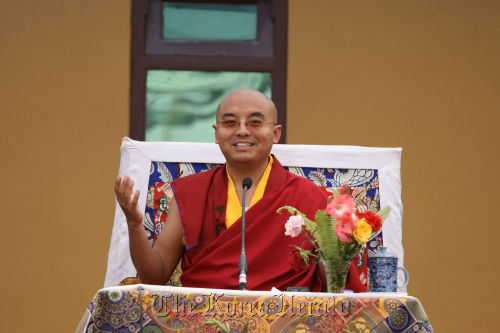Born near the border between Tibet and Nepal, Rinpoche devoted his life to Buddhism from an early age, along with a strong interest in the sciences, and rose quickly to become known as one of a new generation of teachers making Buddhist teachings relevant to today’s society.
He now guides the work of the Tergar Meditation Community and, for the past 10 years, Rinpoche has been travelling the world, organizing meditation retreats and programs and speaking on his philosophies.
His first book, “The Joy of Living: Unlocking the Secret and Science of Happiness” hit the New York Times’ bestseller list, and attracted quite a following including longtime Buddhist, actor Richard Gere.
Rinpoche’s sense of humor and worldly knowledge appear to be a product of the life he has made for himself, and he seems entirely at ease with that. “I have many homes so ... I have no problem (traveling) now.”
There was one thing he hankered for though: “I miss doing retreats.”
A lesson in relaxation
Addressing a packed theater at the Jogyesa temple complex in Insa-dong, Seoul, on Sunday, Rinpoche gave an accessible tutorial on meditation.
Soon the entire room was absorbed in silence, eyes closed, muscles relaxed and spines straight.
“Breathe in, breathe out,” instructed Rinpoche. “Just relax.”
But these were really the only directions needed, for this, he said, was “non-meditation.”
“Non-meditation is the best meditation,” he explained, saying that our tendency to over-think it, to focus on meditating, can take away from the calm, sense of clarity and heightened awareness that should be felt.
As for posture, he said, do not be preoccupied by it. If you can, cross your legs, but always maintain a straight spine so energy can flow through your body. As for thoughts, we should not try and block them but let them pass through.
Westerners, said Rinpoche, imitating a typical cross-legged meditation pose with hands on knees, tend to believe they should think of nothing but peace ― serving only to create artificial peace.
Asians, on the other hand, are more serious, he said, mimicking a rigid posture and concentrated face.
Rinpoche believes the most important thing is to relax. It should be a natural, normal practice that we can use in our everyday lives, he said.
“We don’t know how to rest,” he said. But rest, it seems, is the key to successful meditation.
Throughout the session he went through other techniques, including “sound” and “sleeping” meditation.
Focusing on the soft whir of the air conditioner, Rinpoche challenged the audience to embrace sound in meditation, rather than be deterred by it, to encourage the focus of thoughts.
For those who find meditation makes them tired, Rinpoche instructed that one should “make friends with sleepiness.”
If you maintain a sense of awareness, do not dream, and awake feeling refreshed with a greater sense of clarity, then sleep during meditation is fine, he said.
Why meditate?
“When I was young, I had this panic disorder and I used my panic as support for my meditation ... my panic was one of my best teachers,” he said, explaining that meditation is now being used by some doctors in medical treatment.
He wanted to share this ― through books, retreats and monastic endeavors ― and show that a rested mind can help in many areas of our lives, from study to business. He explained that when we are stressed, we tend to make mistakes and meditation can help alleviate this.
A simple message
However skeptical one is about faith and its leaders, Rinpoche’s message ― delivered through understanding and humorous anecdotes ― was simple: Remember to take time to appreciate what you have.
Among Rinpoche’s fans, there was clear excitement ― one man came from Tokyo and told the audience how special this meeting was for him ― and most joined the long line to get books signed, or to ask questions. Walking through Insa-dong he was keenly followed, given gifts and asked for advice.
Following his upcoming three-year hiatus, Rinpoche plans to return to Korea.
“I think Korea has a lot of traditions still living: meditation traditions and study. Nice people, nice food and nice environment.”
For more on Rinpoche and the Tergar Meditation Community, visit http://tergar.org/.
By Hannah Stuart-Leach (
hannahsl@heraldcorp.com)








